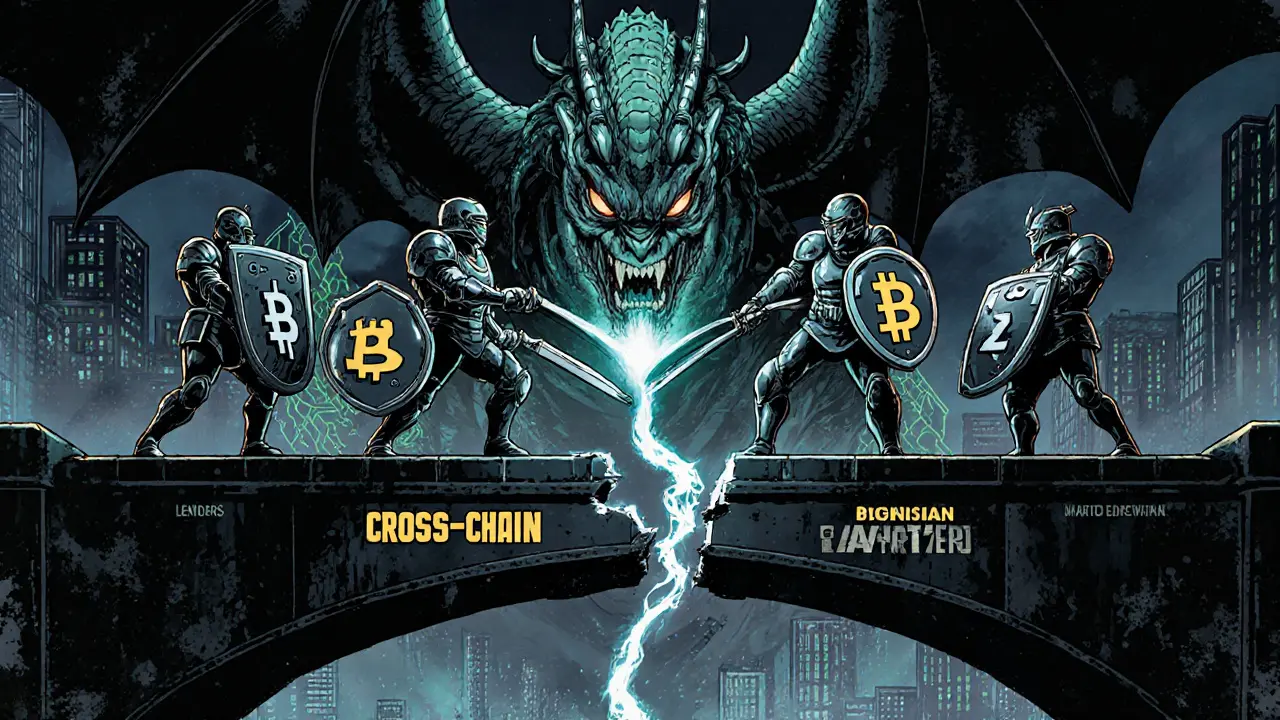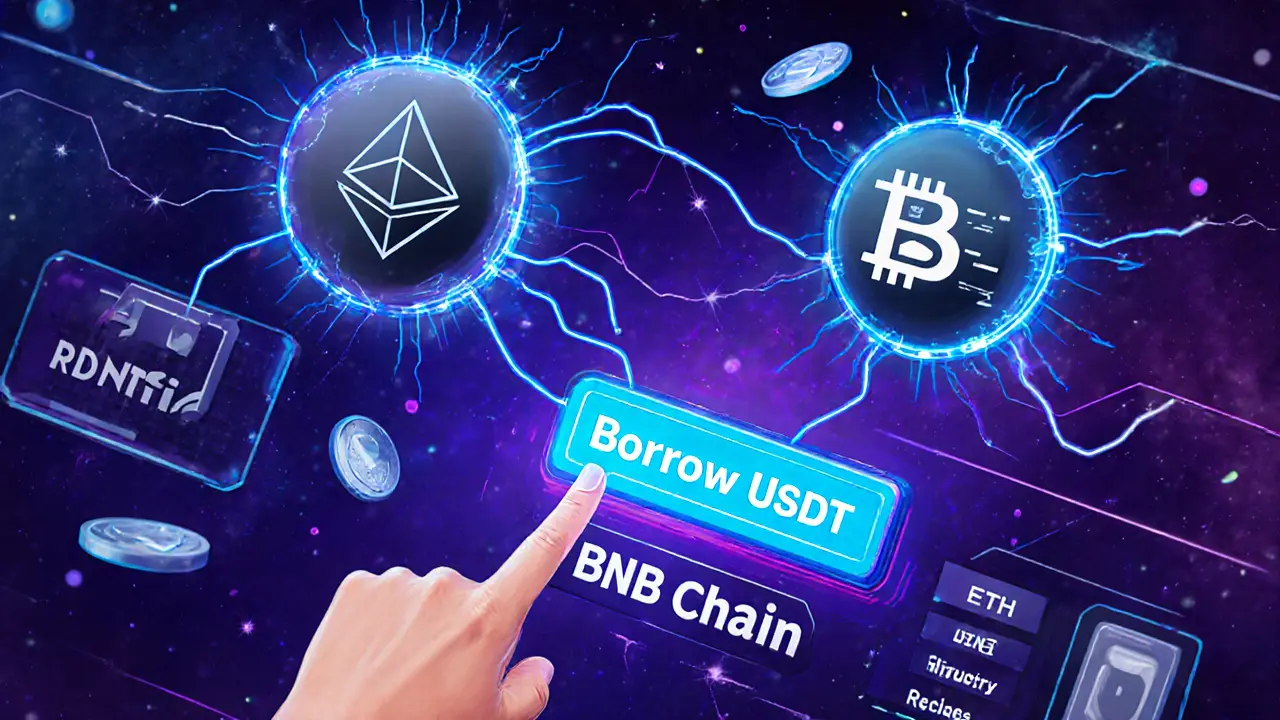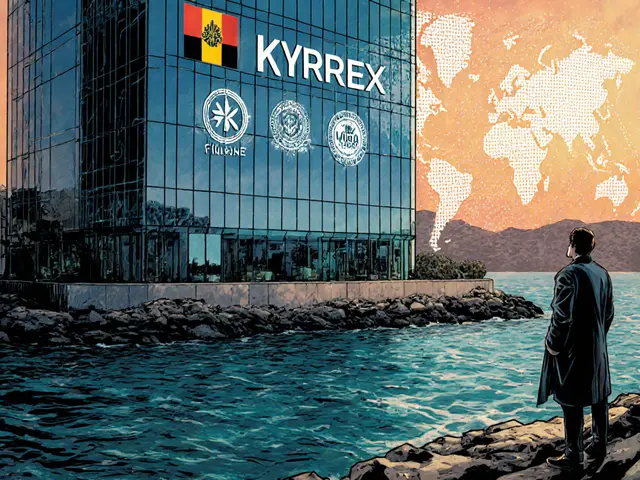What is Radiant Capital (RDNT) Crypto Coin? A Clear Guide to the Omnichain DeFi Token
Radiant Capital Cross-Chain Lending Calculator
Calculate Your Potential Returns
See how much you could earn by depositing assets on one chain and borrowing on another with Radiant Capital. This calculator shows estimated returns including RDNT rewards.
Estimated Returns
Deposit Rate: 0.00%
Borrow Rate: 0.00%
Estimated Interest Earned: 0.00 USDC
Estimated Interest Paid: 0.00 USDT
RDNT Rewards: 0.00 RDNT
Total Estimated Value: 0.00 USD
Note: These are estimated returns based on current market rates. Actual returns may vary due to market volatility, liquidity changes, and protocol updates.
Most crypto coins live on one blockchain. You deposit ETH on Ethereum, borrow USDC on Polygon, and bridge assets between chains using clunky tools that cost time and money. But what if you could deposit ETH on Arbitrum and instantly borrow USDT on BNB Chain - all from one screen, with no bridges? That’s the core idea behind Radiant Capital and its token, RDNT.
What Exactly Is Radiant Capital?
Radiant Capital isn’t just another DeFi lending platform. It’s a cross-chain lending protocol built to fix one of DeFi’s biggest headaches: fragmented liquidity. Instead of having separate lending pools on Ethereum, Arbitrum, BNB Chain, and others, Radiant connects them all. You can deposit any supported asset on any chain and borrow any other supported asset on any other chain - no wrapping, no bridging, no manual swaps. The protocol runs on LayerZero, a cross-chain messaging system that lets blockchains talk to each other securely. It also uses Stargate’s stablecoin router to move value efficiently. This means when you lend on Arbitrum, your funds can be used to power a borrow on BNB Chain, and vice versa. Liquidity isn’t locked in silos anymore - it flows where it’s needed. The whole thing is governed by the RDNT token. Holders vote on upgrades, fee structures, and new asset listings. It’s not just a reward token - it’s the backbone of the system.How Does RDNT Work?
RDNT has two main jobs: governance and incentives. First, governance. If you hold RDNT, you can propose or vote on changes to the protocol. Want to add SOL as a collateral asset? Or change the interest rate model? You need RDNT to make it happen. The more you lock up, the more voting power you have. Second, incentives. Radiant pays out RDNT rewards to three groups:- Lenders who deposit assets
- Borrowers who take out loans
- Liquidity providers who stake RDNT paired with WETH in pools
What Assets Can You Use on Radiant Capital?
Right now, Radiant supports eight major assets across Ethereum, Arbitrum, and BNB Chain:- USDC
- USDT
- sDAI
- ETH
- wstETH
- rETH
- ARB
- BNB
- Deposit ETH on Arbitrum → Borrow USDC on BNB Chain
- Deposit USDT on BNB Chain → Borrow wstETH on Ethereum

How Is Radiant Different From Aave or Compound?
Aave and Compound are the giants of DeFi lending. They’re safe, well-audited, and have billions locked in. But they’re single-chain. If you’re on Ethereum, you can’t directly borrow from a pool on Polygon without bridging first - and bridging means extra steps, higher fees, and more risk. Radiant cuts out the middleman. You don’t need to bridge. You don’t need to wrap assets. You just pick your deposit chain and your borrow chain, and the protocol handles the rest. Here’s a quick comparison:| Feature | Radiant Capital | Aave | Compound |
|---|---|---|---|
| Chains Supported | Multi-chain (Arbitrum, BNB Chain, Ethereum) | Single-chain (Ethereum, with limited cross-chain via bridges) | Single-chain (Ethereum) |
| Cross-Chain Borrowing | Yes - native, no bridges | No - requires external bridges | No |
| Rewards for Borrowers | Yes - RDNT incentives | No - only lenders get rewards | No |
| Total Value Locked (TVL) | ~$150M (late 2023) | ~$1.2B | ~$650M |
| Token Utility | Governance + Incentives | Governance only | Governance only |
Is RDNT a Good Investment?
As of November 2023, RDNT trades around $0.011. Its market cap sits at $15.8 million, making it a small-cap crypto. That means high volatility - and high risk. Some analysts predict RDNT could hit $0.15 by 2030 and even $18 by 2050. Those are long-term, speculative guesses. They assume Radiant becomes the dominant cross-chain lending protocol - a big “if.” Right now, RDNT’s value comes from its utility. If you use the platform, you earn RDNT. If you hold it, you can vote. If you stake it, you earn more. It’s not a pure speculation play like some memecoins. It’s tied to actual usage. But here’s the catch: Radiant still has a lot to prove. Its TVL is tiny compared to Aave. Liquidity for some asset pairs is thin. And if Ethereum-based DeFi keeps growing, will users really switch? The backing from Binance Labs and the Arbitrum Foundation helps. So do the audits from Blocksec. But adoption is the real test.How to Get Started With Radiant Capital
You don’t need to be a crypto expert, but you should know the basics: wallets, gas fees, collateralization. Here’s how to start:- Get a Web3 wallet like MetaMask or Coinbase Wallet.
- Buy some ETH, USDC, or USDT on a centralized exchange like Binance or Kraken.
- Send those assets to your wallet on Arbitrum, BNB Chain, or Ethereum.
- Go to radiant.capital and connect your wallet.
- Choose an asset to deposit. Pick the chain you want to deposit on.
- Select what you want to borrow and on which chain.
- Confirm the transaction. You’re now lending and borrowing cross-chain.
What Are the Risks?
Radiant isn’t risk-free. Here’s what to watch for:- Liquidity gaps: Some asset pairs have low depth. You might get worse rates than on Aave.
- Slippage: Cross-chain swaps can have price changes during execution, especially with large amounts.
- Smart contract risk: Even with audits, new protocols can have hidden bugs. LayerZero has had issues before.
- Regulation: If governments crack down on DeFi governance tokens, RDNT could be targeted.
- Competition: Stargate Finance and other cross-chain projects are catching up.
Who Is Radiant Capital For?
Radiant is perfect for:- DeFi users who move between chains regularly
- Traders who want to arbitrage interest rates across networks
- Investors who believe cross-chain DeFi is the future
- Beginners who don’t understand collateral ratios
- People who want the highest APY on a single chain
- Those who avoid new protocols with low TVL
What’s Next for Radiant Capital?
The team is working on:- Adding more chains - Solana and Base are rumored
- Enabling DAO voting with locked RDNT
- Integrating with more DeFi protocols for yield stacking
- Improving the user interface to reduce confusion
Is RDNT a good long-term investment?
RDNT isn’t a guaranteed winner. Its value depends entirely on adoption. If Radiant becomes the go-to cross-chain lending platform, RDNT could rise significantly. But if it stays small or gets outcompeted, the price may stay flat or drop. It’s a high-risk, high-reward bet on a specific use case - not a broad crypto play.
Can I stake RDNT to earn rewards?
Yes, but not directly. You can’t just stake RDNT alone. You need to provide liquidity by pairing RDNT with WETH in a pool on the platform. This makes you a Dynamic Liquidity Provider (dLP), and you earn a share of protocol fees and RDNT rewards. It’s more complex than staking, but the returns can be higher.
How do I buy RDNT?
You can buy RDNT on decentralized exchanges like Uniswap or PancakeSwap. Search for the RDNT token pair (usually RDNT/USDT or RDNT/WETH). You’ll need a Web3 wallet and some ETH or BNB to pay for gas. Avoid centralized exchanges unless they list it - most don’t yet.
Is Radiant Capital safe?
Radiant has been audited by Blocksec and other reputable firms. Its smart contracts are open-source. But it’s still a new protocol with lower TVL than giants like Aave. Cross-chain systems add complexity - and risk. Don’t deposit more than you’re willing to lose. Use only what you understand.
What’s the difference between RDNT and other DeFi tokens like AAVE or COMP?
AAVE and COMP are governance tokens for single-chain protocols. RDNT is for a cross-chain protocol that rewards borrowers - something no other major DeFi token does. RDNT also has a much larger circulating supply (1.31B vs. AAVE’s 147M), which affects price dynamics. It’s a different model designed for a different problem.
If you’re curious about cross-chain DeFi, Radiant Capital is one of the most interesting experiments right now. It’s not perfect. It’s not the biggest. But it’s trying to solve a problem most people ignore - and that might be exactly what the next phase of DeFi needs.






19 Comments
Dave Sorrell
November 24 2025Radiant Capital is actually one of the more thoughtful attempts at solving cross-chain fragmentation. Most DeFi projects just tack on bridges and call it a day. Radiant’s use of LayerZero and Stargate is technically sound. The borrower incentives are smart too - you need both sides of the market to work, not just lenders. It’s not perfect, but it’s one of the few protocols actually building for real user behavior, not just speculative yield farming.
Jody Veitch
November 26 2025Let’s be honest - this is just another ‘DeFi 2.0’ buzzword salad wrapped in LayerZero hype. You’re telling me I should trust a protocol with $150M TVL over Aave’s $1.2B? The fact that they reward borrowers is a band-aid for poor liquidity design. Real DeFi doesn’t need incentives to attract users - it needs security, scale, and proven audits. This feels like a VC-funded vanity project with a token dump waiting to happen.
Sky Sky Report blog
November 26 2025Interesting approach. I like that they’re trying to remove the friction of bridging. I’ve lost money on failed bridge transactions before. If this works reliably, it could change how people move between chains. Still, I’d want to see more real-world usage before putting anything significant in.
stuart white
November 27 2025Just tried Radiant last week. Deposited ETH on Arbitrum, borrowed USDT on BNB Chain - worked without a hitch. Gas was low, interface was clean. The dLP pool is a bit confusing at first, but once you get it, the rewards are solid. No bridge, no wrapping, no waiting. This is what DeFi should feel like.
Jane A
November 27 2025Of course it’s a pump-and-dump. Look at the supply - 1.31 billion tokens. That’s a joke. Someone’s getting rich off this while retail gets stuck with the bag. Don’t fall for the ‘utility’ narrative. It’s all marketing. RDNT is going to zero.
asher malik
November 27 2025There’s something poetic about this - a protocol that doesn’t care which chain you’re on. We’ve been stuck in silos for years. Ethereum purists, Solana fanboys, BNB loyalists - all of us fighting over who’s better. Radiant just… works. It doesn’t ask you to pick a side. Maybe that’s the real innovation. Not the tech - the philosophy.
Tyler Boyle
November 27 2025Let’s break this down. Radiant’s architecture relies on LayerZero’s omnichain messaging layer, which itself depends on a consensus mechanism between relayers and observers - a model that’s been criticized for centralization risks. Combine that with Stargate’s token bridge, which has had multiple exploits in the past, and you’re stacking two non-trivial attack surfaces. The fact that they’re rewarding borrowers is an economic hack to bootstrap liquidity, but it also creates a perverse incentive: users may borrow just to earn RDNT, then immediately sell it, creating downward pressure on price. The dLP model is essentially a liquidity mining scheme disguised as yield optimization. And don’t get me started on the tokenomics - 1.5B total supply with 87% in circulation means massive inflationary pressure unless locking mechanisms are strictly enforced. Most users don’t realize that voting power is concentrated in a few wallets - the DAO is already de facto centralized. And yes, the interface is confusing because they’re trying to abstract away too much complexity for non-technical users. This isn’t DeFi for the masses - it’s DeFi for the marginally sophisticated who don’t read the whitepaper.
Lisa Hubbard
November 29 2025I read the whole thing. It’s long. Too long. I don’t care about LayerZero or Stargate. I just want to know if I can deposit my USDC and get USDT somewhere else without paying $50 in gas and waiting 20 minutes. And even then - is it worth it? Probably not. I’ll stick with Aave. It’s boring, but it works.
Belle Bormann
November 29 2025i tried radiant and it worked fine but i think u need to use arbi or bnb chain for lower fees. eth is still too expensive. also the site was a little slow on mobile.
Jennifer Morton-Riggs
November 30 2025It’s funny how people call this ‘innovation’ when it’s really just borrowing from other protocols and slapping a token on it. LayerZero? Stargate? RDNT? It’s all just repackaged tech. The real question is - why should I care? What’s my incentive beyond hoping the token goes up? I’ve been burned too many times by ‘utility tokens’ that turned out to be glorified speculation tickets. This feels like the same story, just with a new name.
Jenny Charland
November 30 2025RDNT is gonna hit $0.50 by end of year. I’m buying the dip. Everyone else is sleeping on this. You’ll regret it later. 🚀
Soham Kulkarni
December 1 2025in india we dont have easy access to arb or bnb chain. maybe next time add support for polygon or solana. also can we buy rdnt on binance? i dont want to use uniswap.
Tejas Kansara
December 1 2025Good guide. Start with small amounts. Test the flow. Don’t rush. If it works for you, then scale. DeFi is about learning, not gambling.
preet kaur
December 1 2025As someone from India, I’ve seen how DeFi can help bypass traditional banking limits. Radiant might not be perfect, but it’s a step toward true global finance. No borders, no middlemen. That’s powerful.
Rajesh pattnaik
December 3 2025Back home in India, we call this ‘connecting the dots’. The chains are like different villages, and Radiant is the road between them. Simple. Clean. No need for extra steps. I like that.
Kathy Alexander
December 3 2025They’re using LayerZero - the same tech that got exploited last year. And now they’re giving out RDNT to borrowers? That’s not innovation, that’s desperation. The whole thing smells like a rug pull in training. Just wait - the team will dump their tokens after the next pump. Don’t be the last one holding.
Matthew Prickett
December 5 2025Did you know the Radiant team has ties to a shell company registered in the Caymans? And the lead dev used to work for a crypto project that got sued for insider trading? The audits? They’re all from firms that also audited FTX. Coincidence? I think not. This isn’t DeFi - it’s a financial Ponzi with a blockchain skin.
Gus Mitchener
December 7 2025The dLP mechanism is essentially a liquidity provision protocol operating under a novel incentive alignment framework - where borrower participation is gamified through tokenized marginal utility capture. This creates a non-linear feedback loop between liquidity depth and token velocity, effectively decoupling collateral efficiency from chain-specific silos. The real innovation lies not in the cross-chain abstraction, but in the economic equilibrium it establishes between opposing liquidity flows - a concept previously unattainable in single-chain AMMs.
jocelyn cortez
December 7 2025Thanks for writing this. I’ve been scared to try cross-chain stuff because I didn’t understand it. This made it feel less scary. I’m going to try it with a small amount this weekend.